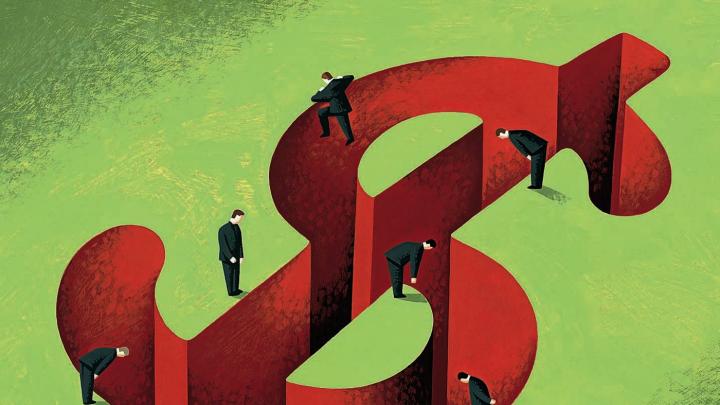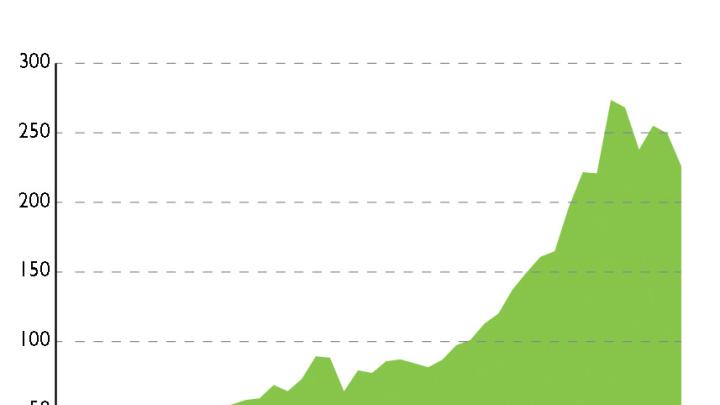The Great Recession fades from memory, but its effects linger. Nations around the globe still carry its legacy in the form of substantial public and private debt. How governments have dealt with such “debt overhangs” in the past 200 years is the subject of a paper by Carmen Reinhart, Zombanakis professor of the international financial system at Harvard Kennedy School; Vincent Reinhart of the American Enterprise Institute; and Kenneth S. Rogoff, Cabot professor of public policy. The authors say that many observers have forgotten about some of the tools that even advanced economies have used in the past to lessen their obligations.
The aftermath of the recent recession was unusual, Carmen Reinhart pointed out in an interview, in that the levels of debt incurred were more characteristic of the accrued sums confronted in postwar periods like those following World Wars I and II, but the inherent recovery mechanisms typically seen at war’s end—the return of a larger labor force, the deployment of resources to economic goods rather than wartime production—did not apply. The reason that debt levels are now so high has everything to do with context, she explained. In addition to government debt, there was massive private borrowing by individuals and the financial sector in advanced economies around the world before the crisis; they took advantage of low interest rates to finance spending—a process now repeating itself in emerging Asia and elsewhere, she said. When sub-prime borrowers defaulted on their mortgage payments, financial institutions were left with the debt. Pension funds also carry large liabilities on their books, mainly related to demographic pressures associated with an aging workforce.
During the ensuing recovery, much of the private and institutional debt was converted to government debt (both in the United States and abroad, notably in Ireland and Spain), through assistance to distressed financial institutions and through mortgage-relief programs for qualified homeowners, for example. That’s a positive development, Reinhart said, because officially held debt (i.e., held by a government, multilateral institution, or central bank) can be restructured more easily than privately held debt.
Today, the debt levels in many advanced economies exceed 100 percent of gross domestic product (GDP). In the United States, for example, government debt is currently 105 percent of GDP, a level from which most governments have historically tried to retreat (as a hedge against the possibility that they might need to borrow during a future catastrophe). The ideal exit strategy from large debt overhangs, according to the Reinharts and Rogoff, is through growth—but that is often difficult to achieve. When an economy grows, even if the absolute level of debt remains the same, it slowly becomes a smaller proportion of GDP. Productivity gains have driven expansion in many economies—the “iconic example,” Reinhart noted, being Ireland in the 1990s. Foreign investment there led to modernization and massive gains in efficiency, fueling substantial growth. But that way out, however ideal, is just one of many means by which governments, including advanced economies, have managed debt.
The Reinharts and Rogoff include growth among a set of orthodox methods for reducing public debt that have been widely deployed since World War II. Increased government spending can stimulate an economy if there are good investments to make in social or public infrastructure. Some governments raised taxes, reduced government spending, or employed a combination of the two, so the state ran primary budget surpluses (a deficit representing government spending, minus current income from taxes, that excludes interest costs). Another strategy, rarely deployed in the United States, was to privatize government assets by turning control of public functions over to private companies.
But in examining 70 debt episodes across 22 advanced economies from 1800 to 2014, the authors find far greater reliance than “many observers choose to remember” on what they call heterodox approaches to debt reversal. Among such approaches is outright default (or restructuring, i.e., partial default), usually on external debt (funds lent from abroad). This option is frequently thought of as exclusively used by emerging economies, but after World War I, all of Europe except Finland defaulted on its debt obligations to the U.S. government, including France, Germany, Italy, and the United Kingdom. So did the United States, in regard to domestic debt: during the Great Depression, President Franklin D. Roosevelt forced conversion of all privately owned gold currency to the government at a fixed price, and simultaneously forced restructuring of contracts backed by the metal (the so-called abrogation of the gold clause). Debt may also be eroded through inflation, but this is more often an unanticipated, unplanned event. (Inflation makes it easier to repay borrowed funds, as the value of the currency erodes.)
Wealth taxes form the other major response category to paying down large public obligations. Perhaps the most subtle and interesting tactic involves “financial repression,” which occurs when real interest rates turn consistently negative. An example of this “gradual tax” occurs when large holders of government debt, such as Treasury bonds, end up accepting a “risk-free” rate of return that is less than inflation. There are many reasons why this may make sense even for the holders of the debt, whose investment will slowly lose value. Risk-free assets may be appealing for very wealthy individuals, as a hedge against potential catastrophic losses. Foreign nations also purchase debt, such as U.S. Treasury bonds, to keep their currencies from appreciating against the dollar, thereby ensuring the health of emerging economies that rely on exports to the United States. (In such cases, the debt holders don’t care as much about the rate of return, Reinhart pointed out. “The objective of asymmetric monetary policies in export-dependent emerging economies is to maintain demand for their goods and services.”)
Domestically, the “essence of ‘financial repression’ is to place debt at financial institutions”—such as banks, pension funds and insurance companies—“via regulatory changes,” Reinhart continued. In the United States, for example, “banks are now required to hold more government debt in their portfolios.” Such tactics, which reach their apex in the advanced economies of Europe, work because surrounding countries are also doing it; the lack of alternatives deters leakage of funds to other economies that offer more attractive rates of return.
During the recent financial crisis, the U.S. Federal Reserve Board “was very aggressive in buying toxic assets and restoring the workings of the credit market,” which is one reason the American economy is faring relatively well, Reinhart explained. But in “periphery Europe,” including countries such as Greece, Portugal, and maybe even Italy, she predicts further restructurings of official debt. “The main point that we try to make in this paper,” she concluded, “is that governments have historically used a variety of tools for dealing with debt,” and tackling the overhang left by the Great Recession may require them to consider all the options.










